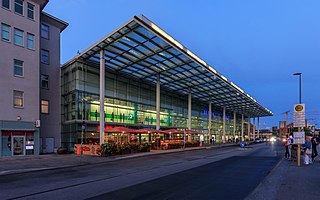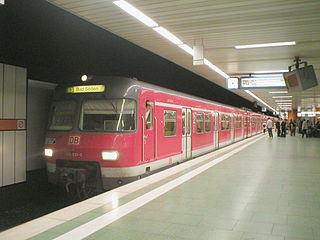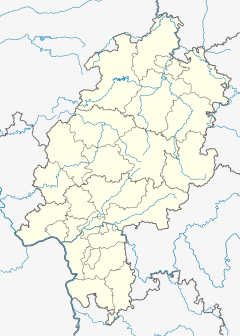
Berlin Hauptbahnhof is the main railway station in Berlin, Germany. It came into full operation two days after a ceremonial opening on 26 May 2006. It is located on the site of the historic Lehrter Bahnhof, and until it opened as a main line station, it was a stop on the Berlin S-Bahn suburban railway temporarily named Berlin Hauptbahnhof–Lehrter Bahnhof. The station is operated by DB Station&Service, a subsidiary of Deutsche Bahn AG, and is classified as a Category 1 station, one of 21 in Germany and four in Berlin, the others being Berlin Gesundbrunnen, Berlin Südkreuz and Berlin Ostbahnhof.

Berlin-Lichtenberg is a railway station in Berlin, Germany. It is located on the Eastern Railway, Wriezen Railway and Berlin Frankfurter Allee–Berlin-Rummelsburg railway lines in the Lichtenberg district. The station is also part of the Berlin S-Bahn and U-Bahn network.

Berlin Ostbahnhof is a main line railway station in Berlin, Germany. It is located in the Friedrichshain quarter, now part of Friedrichshain-Kreuzberg borough, and has undergone several name changes in its history. It was known as Berlin Hauptbahnhof from 1987 to 1998, a name now applied to Berlin's new central station at the former Lehrter station. Alongside Berlin Zoologischer Garten station it was one of the city's two main stations; however, it has declined in significance since the opening of the new Hauptbahnhof on 26 May 2006, and many mainline trains have been re-routed on the North–South mainline through the new Tiergarten tunnel, bypassing Ostbahnhof.

München Hauptbahnhof is the main railway station in the city of Munich, Germany. It is one of the three long distance stations in Munich, the others being München Ost and München-Pasing. München Hauptbahnhof sees about 450,000 passengers a day, which puts it on par with other large stations in Germany, such as Hamburg Hauptbahnhof and Frankfurt Hauptbahnhof. It is classified by Deutsche Bahn as a category 1 station, one of 21 in Germany and two in Munich, the other being München Ost. The mainline station is a terminal station with 32 platforms. The subterranean S-Bahn with 2 platforms and U-Bahn stations with 6 platforms are through stations.

Frankfurt (Main) Süd or Frankfurt Südbahnhof is one of three railway stations for long-distance train services in Frankfurt, Germany. Unlike Frankfurt Hauptbahnhof it is not a terminus but a through station, and has nine tracks with five platforms. It is a stopping station for some long-distance routes and for regional traffic. It is also one of the major rapid-transit railway hubs in the city with S-Bahn and U-Bahn services.
The Frankfurt–Bebra railway runs from Bebra to Frankfurt am Main via Fulda, Gelnhausen, Hanau and Offenbach am Main in south central Germany. The southern section between Fulda and Frankfurt is known as the Kinzig Valley railway due to the route it follows through the Kinzig Valley.
The Main–Weser Railway is a railway line in central Germany that runs from Frankfurt am Main via Gießen to Kassel. it is named after the railway company that built the line and also operated it until 1880. It was opened between 1849 and 1852 and was one of the first railways in Germany.

The Frankfurt City Tunnel is standard gauge railway in Frankfurt and the core of the Rhine-Main S-Bahn. The line runs underground for its entire length.
The Frankfurt–Hanau railway was opened in 1848 and was one of the oldest railways in Germany. Today it is a double track electrified main line and part of the North Main Railway from Frankfurt am Main to Hanau.

The Line C is a line on the Frankfurt U-Bahn. It consists of the U6 and the U7.

The Frankfurt (Oder) station is the main passenger station in Frankfurt (Oder). It is one of the most important railway stations in the German state of Brandenburg. It is served by regional and long-distance services and since 1945 it has been a border station for transport to and from Poland. The station has been substantially rebuilt several times. A building on the grounds of the first Frankfurt station, north of the current station, is heritage-listed, as are the Kiliansberg apartments, which were built as a railway settlement at the station forecourt, and a monument to railwaymen who fell in the First World War in the same area.

Frankfurt-Nied station is a station in the district of Nied of the city of Frankfurt in the German state of Hesse on the Main-Lahn Railway. It is now served only by lines S1 and S 2 of the Rhine-Main S-Bahn. The station is classified by Deutsche Bahn as a category 5 station.

Steinheim (Main) station is a station on the Frankfurt–Hanau railway in Hanau in the German state of Hesse. The station is classified by Deutsche Bahn (DB) as a category 5 station.

Maintal Ost (east) station is a station in the zone of the Rhine-Main Transport Association on the Frankfurt-Hanau Railway, serving the Maintal districts of Hochstadt and Dörnigheim in the German state of Hesse. The station is classified by Deutsche Bahn (DB) as a category 4 station.

Hanau West station is the oldest station in the city of Hanau in the German state of Hesse. It was opened in 1848 and is located on the 17.9 kilometre mark of the Frankfurt-Hanau Railway. Operationally, since the 1970s it has been classified as a Haltepunkt (“halt”). The station is classified by Deutsche Bahn (DB) as a category 5 station.

Frankfurt-Mainkur station is located on the Frankfurt-Hanau Railway between Frankfurt East station and Hanau Central Station in the Frankfurt district of Fechenheim in the German state of Hesse. The station is classified by Deutsche Bahn (DB) as a category 5 station.

S21 is a term of the Berlin S-Bahn with several usages:
































